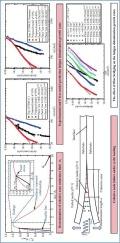Fatigue-free cohesive zone model for fatigue delamination prediction in fiber reinforced composite laminates
IF 5.6
2区 工程技术
Q1 ENGINEERING, MECHANICAL
引用次数: 0
Abstract
This work proposes a Fatigue-free cohesive zone model (F-free model) for predicting fatigue delamination growth in fiber reinforced composite laminates. Unlike traditional empirical approaches that rely on fatigue test calibration, the F-free model is grounded in mechanics and requires only quasi-static delamination data. The formulation combines Timoshenko beam theory with a fatigue cohesive zone model, where the interfacial toughness evolves with crack length to account for the influence of bridging fibers. A proof-stress-inspired method is used to define the cohesive zone endurance limit, eliminating the need for fatigue-specific testing. The model is validated against two benchmark cases. The predicted fatigue delamination growth rates show excellent agreement with experimental data, and the results indicate that the model predictions successfully encompass the full range of observed growth rates. Additionally, the Paris’ law exponents derived from model predictions closely match those obtained from the experimental data. Beyond accuracy, the approach offers physical insight into the mechanical role of fiber bridging, revealing its effect in raising the fatigue threshold and steepening the crack growth curve. Overall, the model provides a robust framework that does not require fatigue data for simulating fatigue delamination growth in fiber reinforced composite laminates.

纤维增强复合材料层合板疲劳分层预测的无疲劳粘聚区模型
本文提出了一种预测纤维增强复合材料层合板疲劳脱层生长的无疲劳内聚区模型(F-free模型)。与依赖于疲劳试验校准的传统经验方法不同,无f模型以力学为基础,只需要准静态分层数据。该公式将Timoshenko梁理论与疲劳黏结区模型相结合,其中界面韧性随裂纹长度的变化而变化,以考虑桥接纤维的影响。采用抗应力启发方法来确定粘接区耐久极限,从而消除了疲劳特定测试的需要。该模型通过两个基准案例进行了验证。预测的疲劳脱层增长率与实验数据吻合良好,结果表明模型预测成功地涵盖了观察到的增长率的全部范围。此外,从模型预测中得出的巴黎定律指数与从实验数据中得到的指数非常吻合。除了准确性之外,该方法还提供了对纤维桥接力学作用的物理洞察,揭示了其在提高疲劳阈值和变陡裂纹扩展曲线方面的作用。总的来说,该模型为模拟纤维增强复合材料层合板的疲劳分层生长提供了一个不需要疲劳数据的稳健框架。
本文章由计算机程序翻译,如有差异,请以英文原文为准。
求助全文
约1分钟内获得全文
求助全文
来源期刊

Theoretical and Applied Fracture Mechanics
工程技术-工程:机械
CiteScore
8.40
自引率
18.90%
发文量
435
审稿时长
37 days
期刊介绍:
Theoretical and Applied Fracture Mechanics'' aims & scopes have been re-designed to cover both the theoretical, applied, and numerical aspects associated with those cracking related phenomena taking place, at a micro-, meso-, and macroscopic level, in materials/components/structures of any kind.
The journal aims to cover the cracking/mechanical behaviour of materials/components/structures in those situations involving both time-independent and time-dependent system of external forces/moments (such as, for instance, quasi-static, impulsive, impact, blasting, creep, contact, and fatigue loading). Since, under the above circumstances, the mechanical behaviour of cracked materials/components/structures is also affected by the environmental conditions, the journal would consider also those theoretical/experimental research works investigating the effect of external variables such as, for instance, the effect of corrosive environments as well as of high/low-temperature.
 求助内容:
求助内容: 应助结果提醒方式:
应助结果提醒方式:


